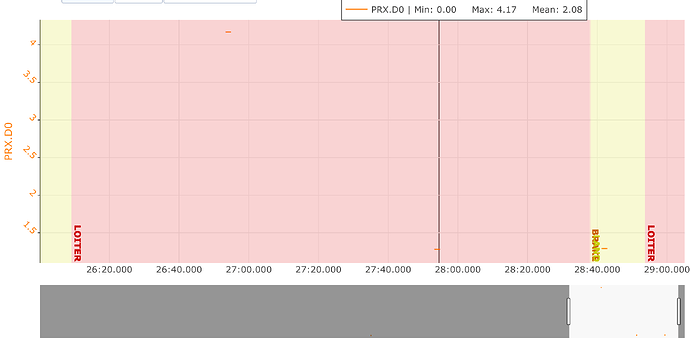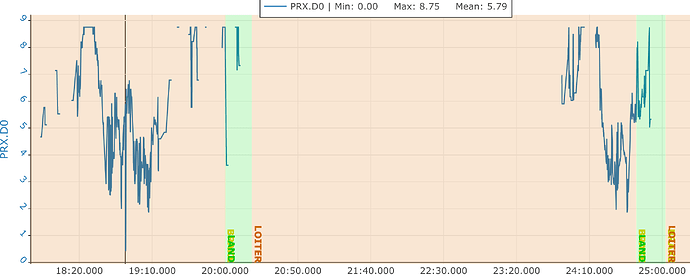If it helps, here is the script I run on my Nano:
import cv2
import numpy as np
import time
import depthai as dai
from pymavlink import mavutil
newConfig = False
##########################
# Setup DepthAI pipeline #
##########################
# Create DepthAI pipeline
pipeline = dai.Pipeline()
# Define DepthAI sources and outputs
monoLeft = pipeline.create(dai.node.MonoCamera)
monoRight = pipeline.create(dai.node.MonoCamera)
stereo = pipeline.create(dai.node.StereoDepth)
spatialLocationCalculator = pipeline.create(dai.node.SpatialLocationCalculator)
xoutDepth = pipeline.create(dai.node.XLinkOut)
xoutSpatialData = pipeline.create(dai.node.XLinkOut)
xinSpatialCalcConfig = pipeline.create(dai.node.XLinkIn)
xoutDepth.setStreamName("depth")
xoutSpatialData.setStreamName("spatialData")
xinSpatialCalcConfig.setStreamName("spatialCalcConfig")
# Setting properties for depth AI pipeline
monoLeft.setResolution(dai.MonoCameraProperties.SensorResolution.THE_400_P)
monoLeft.setCamera("left")
monoRight.setResolution(dai.MonoCameraProperties.SensorResolution.THE_400_P)
monoRight.setCamera("right")
stereo.setDefaultProfilePreset(dai.node.StereoDepth.PresetMode.HIGH_DENSITY)
stereo.setLeftRightCheck(True)
stereo.setSubpixel(True)
# Config
topLeft = dai.Point2f(0.45, 0.45)
bottomRight = dai.Point2f(0.55, 0.55)
config = dai.SpatialLocationCalculatorConfigData()
config.depthThresholds.lowerThreshold = 400
config.depthThresholds.upperThreshold = 9000
calculationAlgorithm = dai.SpatialLocationCalculatorAlgorithm.MEDIAN
config.roi = dai.Rect(topLeft, bottomRight)
spatialLocationCalculator.inputConfig.setWaitForMessage(False)
spatialLocationCalculator.initialConfig.addROI(config)
# Linking
monoLeft.out.link(stereo.left)
monoRight.out.link(stereo.right)
spatialLocationCalculator.passthroughDepth.link(xoutDepth.input)
stereo.depth.link(spatialLocationCalculator.inputDepth)
spatialLocationCalculator.out.link(xoutSpatialData.input)
xinSpatialCalcConfig.out.link(spatialLocationCalculator.inputConfig)
# Create RGB camera
camRgb = pipeline.create(dai.node.ColorCamera)
camRgb.setPreviewSize(640, 360)
camRgb.setResolution(dai.ColorCameraProperties.SensorResolution.THE_1080_P)
# Create XLinkOut for RGB frames
xoutRgb = pipeline.create(dai.node.XLinkOut)
xoutRgb.setStreamName("rgb")
camRgb.preview.link(xoutRgb.input)
##########################
# Setup MAVLINK connection #
##########################
# Create a MAVLink connection
jetson_nano = mavutil.mavlink_connection('/dev/ttyTHS1', baud=115200)
# Distance sensor frequency should be much faster than heartbeat
heartbeat_frequency = 1 # 1 Hz
distance_sensor_frequency = 40 # 40 Hz
last_heartbeat_time = time.time()
last_distance_sensor_time = time.time()
##########################
# Setup video writer #
##########################
# Define the codec using VideoWriter_fourcc() and create a VideoWriter object.
# Ensure the frame size matches the dimensions of the frames you're writing,
fourcc = cv2.VideoWriter_fourcc(*'mp4v')
# Variables to write video to sd card
video_file_path = '/home/tsungxu/video_test.mp4'
frame_size = (640, 360)
frame_rate = 30.0
# instantiate cv2.VideoWriter before the loop
out = cv2.VideoWriter(video_file_path, fourcc, frame_rate, frame_size)
##########################
# Connect to device and start pipeline
##########################
with dai.Device(pipeline) as device:
# Output queue will be used to get the depth frames from the outputs defined above
depthQueue = device.getOutputQueue(name="depth", maxSize=4, blocking=False)
spatialCalcQueue = device.getOutputQueue(name="spatialData", maxSize=4, blocking=False)
spatialCalcConfigInQueue = device.getInputQueue("spatialCalcConfig")
color = (255, 255, 255)
# print("Use WASD keys to move ROI!")
#!!! rgb output
rgbQueue = device.getOutputQueue(name="rgb", maxSize=4, blocking=False)
while True:
inDepth = depthQueue.get() # Blocking call, will wait until a new data has arrived
inRgb = rgbQueue.get()
# !!! Convert the retrieved rgb frame into a numpy array
frame = inRgb.getCvFrame()
# Write the frame to the file
out.write(frame)
spatialData = spatialCalcQueue.get().getSpatialLocations()
##################
# send heartbeat to flight controller #
##################
# Send a heartbeat message every second. https://mavlink.io/en/mavgen_python/#heartbeat
current_time = time.time()
if current_time - last_heartbeat_time > heartbeat_frequency:
# The arguments for the heartbeat message are type, autopilot, base_mode, custom_mode, system_status, and mavlink_version.
jetson_nano.mav.heartbeat_send(
18, # Type of the system - MAV_TYPE_ONBOARD_CONTROLLER: https://mavlink.io/en/messages/minimal.html#MAV_TYPE
mavutil.mavlink.MAV_AUTOPILOT_INVALID, # Autopilot type
0, # System mode https://mavlink.io/en/messages/common.html#MAV_MODE
0, # Custom mode, this is system specific
3, # System status https://mavlink.io/en/messages/common.html#MAV_STATE
)
last_heartbeat_time = current_time
for depthData in spatialData:
roi = depthData.config.roi
roi = roi.denormalize(width=frame.shape[1], height=frame.shape[0]) # adjust this to frame's dimensions
xmin = int(roi.topLeft().x)
ymin = int(roi.topLeft().y)
xmax = int(roi.bottomRight().x)
ymax = int(roi.bottomRight().y)
depthMin = depthData.depthMin
depthMax = depthData.depthMax
fontType = cv2.FONT_HERSHEY_TRIPLEX
cv2.rectangle(frame, (xmin, ymin), (xmax, ymax), color, 1)
cv2.putText(frame, f"X: {int(depthData.spatialCoordinates.x)} mm", (xmin + 10, ymin + 20), fontType, 0.5, color)
cv2.putText(frame, f"Y: {int(depthData.spatialCoordinates.y)} mm", (xmin + 10, ymin + 35), fontType, 0.5, color)
cv2.putText(frame, f"Z: {int(depthData.spatialCoordinates.z)} mm", (xmin + 10, ymin + 50), fontType, 0.5, color)
##################
# send distance sensor data to flight controller #
##################
# Get the depth in cm (assuming depthData.spatialCoordinates.z is in mm)
depth = int(depthData.spatialCoordinates.z) / 10
# Send DISTANCE_SENSOR message and reset last distance sensor time
# see https://mavlink.io/en/messages/common.html for fields
if current_time - last_distance_sensor_time > 1/distance_sensor_frequency:
jetson_nano.mav.distance_sensor_send(
time_boot_ms=0, # timestamp in ms since system boot
min_distance=40, # minimum distance the sensor can measure (cm)
max_distance=900, # maximum distance the sensor can measure (cm)
current_distance=int(depth), # current distance measured (cm)
type=4, # type of distance sensor: 0 = laser, 4 = unknown. See MAV_DISTANCE_SENSOR
id=1, # onboard ID of the sensor
orientation=0, # forward facing, see MAV_SENSOR_ORIENTATION
covariance=0, # measurement covariance in centimeters, 0 for unknown / invalid readings
)
last_distance_sensor_time = current_time
# # DEBUG print distance sensor data
# if(depth > 300):
# print(depth)
# !!! Show the rgb frame
# cv2.imshow("rgb", frame)
key = cv2.waitKey(1) & 0xFF # Get ASCII value of key
if key == ord('q'):
break
# release video writer
out.release()


